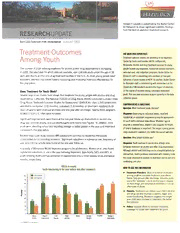
Research Update (2003 August): Treatment Outcomes among Youth PDF
Preview Research Update (2003 August): Treatment Outcomes among Youth
() a -, HazeLDeN Research Update is published bythe ButlerCenter for Research to share significantscientificfindings from the field ofaddictiontreatment research. BUTLER CENTER FOR RESEARCH AUGUST 2003 Treatment Outcomes THEHAZELDENEXPERIENCE Among Youth TreatmentoutcomestudiesareunderwayattheHazelden CenterforYouthandFamilies(HCYF) in Plymouth, Minnesota.Alcoholanddrugtreatmentservicesforyoung The numberofyouth enteringtreatmentforalcohol and/ordrugdependence is increasing. peopleincludedaytreatment, residential primarytreatment, In 2000, the latestyearforwhich data are available, over 134,000 youth underthe age of 18 extendedcare, andoutpatientprograms. ButlerCenterfor were admitted to alcohol and drugtreatmentfacilities in the U.S. As moreyoung people need Researchstaffiscompletingdata analysesonfive-year treatment, attention has turned toward measuringand improvingtreatmenteffectiveness for outcomesofyouthtreatedatHCYF. Inaddition, ButlerCenter this population. forResearchstaffiscollaboratingwith researchersatthe UniversityofMinnesotatoexaminetheimpactofemotions Does Treatment for Youth Work? onthecourseofrecoveryamongsubstancedependent Several large-scale studies have shown thattreatmentforyoung peoplewith alcohol and drug youth.Thisone-yearoutcomesstudyiscurrentlyinthedata dependence is effective. The National Institute on Drug Abuse (NIDA) conducted a projecttitled, collectionphase. ‘DrugAbuse Treatment OutcomeStudies forAdolescents” (DATOS-A). Over 1,100adolescents CONTROVERSIES&QUESTIONS admitted to residential (3-12 months), outpatient(1-6 months), orshort-term inpatient (5-35 Question:Whattreatmentwar/csthebest? days) programs were assessed at intake and oneyearafter discharge. Twenty three programs located in four U.S. cities were included. Response:Dependingon individual needs, inpatient, residential,oroutpatientprogrammingmaybeappropriate Significant improvementswere found atthe one-yearfollow-up. Reductions in alcohol use, foryouthwithsubstancedependence.Whatevertypeof drug use, criminal ectivity, and suicidal thoughtswere found (see Figure). In addition, more program isdeemed best, researchdatasuggestthelength youth wereattending school and reportingaverageor better grades in theyear post-treatment oftimeintreatmentis important.Thelongerayoungperson compared tothe year before. stays involvedintreatment,thebettertheoveralloutcome. Annther large-scalestudy involved 485 adolescentsadmitted to residential therapeutic Question:Whataboutnicotineuse? communities foralcohol/drug problems. Significantreductions in substance use, frequencyof use, and criminal activitywere found atthe one-yearfollow up. Response:Youthcontinuetousenicotineathigh rates followingtreatmentforalcoholandotherdrugdependence. In a study of Minnesota Model treatment programsforadolescents, Wintersetal. alsofoLmnd Although alcoholand illicitdruguseisatargeted priorityfor substantial reductions in use in the yearfollowingtreatment. Specifically, 54% and 44% of intervention,health problems associatedwithsmokingmake youth enteringtreatment had abstained orexperienced onlya minor relapseatsix and twelve thisissueimportanttoaddressintreatmentand as partofa months, respectively. continuingcareplan. DATOS-Aresults’ HOWTOUSETHIS INFORMATION Youthfunctioningintheyearbeforeandaftertreatment. — Treatment Providers: Worktoenhance motivation 100 amongyouth tocompletetreatmentandattend TwelveStepgroupsafterdischarge. Educateyouth 90 aboutthe “gateway” roleofalcohol use in relapse 80 on illicitdrugs, andemphasizeabstinencefromall chemicalsofabuse. 10 60 — Parents: Treatmentcan reduceyourchild’salcohol 50 anddruguseand improveacademic, legal, and socialfunctioning. Researchsuggeststhe longer 40 yourchild staysinvolved intreatment,thebetter 30 theoutcome. 20 — Policy: Supporteffortsto increaseinsurance 10 coverageforlonger-termtreatmentforyouth. F0.’’i Illicit I egal Arrests Suisidal InSchool Averageor driro Inanlmuanause druguse aO,,:to thoughts citegrades ‘CONTINUEDONBACK <CONTINUEDFROMFRONT Treatment Outcomes Among Youth HZLDN Long-term outcome data are alsoavailable. Brown and colleagues assessed 162 youth at six months and one, two, and fouryears afterdischargefrom an inpatienttreatmentprogram. At each follow-up, youth were asked about substance use in the preceding month. Substantial References decreases in alcohol and drug use were observed in the fouryears aftertreatment, with 1. SubstanceAbuseandMentalHealthSeroicesAdminIstration.120021. theexception of nicotine. In addition, abstinencefrom alcohol and drugswas significantly TreatmentEpisodeDataSet,1994-2000.Available ss,’uv.samhsa. guu/uas/dasis.htm. associated with positive educational and occupational outcomes. 2. MartIn,K.120021.Adolescenttreatoreutprogramsreducedrugabuse, produceotherimprovements.NIDANotes,17.Available wwss.oida.nih. gus/NIDA_rlvtes. What Predicts Sustained Abstinence and Fewer Relapses? 3. User,Y.,Grella,C.E.,Hubbard,R.L.,Hsieh,S.,Fletcher,B.W.,Brown, B.S.,&Alrglin.M.0.12001).Anesaluattunutdrugtreatmeots Perhapsthe most consistentfactor associated with positivetreatmentoutcomes amongyouth bradolescentsin4UScities.ArchivesofGe,reralPsychIatry.58, is treatment completion. In one study, youth who completed treatmentwere twice as likelyto 689-695. 4. iainclrill,N.,Hawke,i..DoLeon,0.,&Yagelka,i.120001.Adolescents reducealcohol and drug use in theyearfollowing treatmentthan were those who lefttreatment intlrerapeuticcumnrenities:One—yearpusttreatmentoutcomes. prematurely:Anotherstudyfound 53% oftreatmentcompleters wereabstinentor had a minor JourrralofPsychsractiveDrugs,32,81-94. 5. Winters,K.C.,Stinclrtield,R.D.,Opland,E..Weller,C.,&Latlmer,VI. relapse at one-yearfollow-up compared to 15% of non-completers. VI.12000).TheettectivvnessottireMInnesotaModelapproachinthe treatmentutadolescentdrugabusers.Addiction,95,601-612. Longertreatmentstays havealso been associated with positive outcomes. In the DAbS-Astudy, 6. Bro’.vrr,S.A..D’Amico,E.1.,McCarthy,D.El.,&Tapert.S.F.120011. those who stayed in treatment longer (90+ days for residential and outpatient, 21+ days for Four-yearuutcumestrunradolescentalcalrulanddrugtreatmerlt. JournalofStridiesonAlcohol,62,381-388. inpatient) were 1.5times more likelyto be drugand alcohol free atone year posttreatment. 7. Kelly.iF..l,hvrs,1,1.0..&Brosvn,S.120001.Anrrlltlsariateprocess modelohadolescent12—stepattendanceandsubstanceateuatceloe Anotherfactor related to positive outcomes amongyouth is Twelve Step meeting attendance tullessinginpatienttreatnrent.PsychologyofAddictireBehaviors,14, 376-389. (i.e. AlcoholicsAnonymous, Narcotics Anonymous). In theirstudyof99 youth, KellyetaL 8. Brnwlr,S.A.,Tapert,S.F.,Tate.SR.,&Abrantes,A.M.120001.Therole found Twelve Step meetingattendance in thefirstthree months afterdischarge from treatment atalcuirulinadolescentrelapseandoutconre.JouriralofPsychoactive Drugs,32.107-115. predicted reduced substance use (independentofaftercareattendance), days in treatment, and pre-treatment levels ofalcohol ordrug use. The data suggest Twelve Step meeting attendance works by maintaining and increasing motivation forabstinence amongyoung people. Notsurprisingly, avoidingalcohol is predictiveofsuccess aftertreatment. Youth rarely report alcohol as a drugofchoice and may hold the mistaken beliefthatalcohol is less problematic than other drugs. Yet, recertt research suggests the use ofalcohol in theyearaftertreatment acts as a “gateway” for relapse on illicitdrugs amongyouth. Other factors associated with reduced alcohol and drug use in the yearfollowing treatment include higher pre-treatment use severity, positive relationshipswith treatmentcounselors, living outside the family homeafterdischarge, and avoidingdeviant peers: Summary Youth alcohol and drug use drops substantiallyfollowing treatmentand edLlcational, occupational, and social functioning improve. Treatmentforyoung peoplewith substance dependence is effective, allowingthem to lead productive, meaningful lives. hazelden.org BUTLER CENTER FOR RESEARCH AIJGUST 2003 The ButlerCenter orResearch inlOrrs and ilrupro\’es recoveryveryices and produces r’esowi’ch that beners rhc held ol addicriou rrcarrnctrr.\Vearededicated rocoisducringclinical research, .-dI.horaringsvirh exrern.yl researchers, and comnrunicarirrgscienrificfindings. ValerieSlaymaker,Ph.D.,Dlrertor Ityouhoneqeestions,orwouldliketorequestcopiesofResearchUpdate, pleasecall800-257-7800ext.4405,emailbutierresearch©hazelden.urg, orraiteBC4,P.O.Box11,CenterCity,MN 55012-0011. 1’2108HazeojerFouoj.iTon ooze.ger rij’,heHze:dr,,logoarererorercI BcR-nooa r’zo<narks<‘ther,azetlenr<,rrdzt,Or 885225 (0008)
